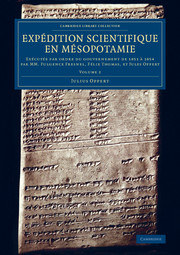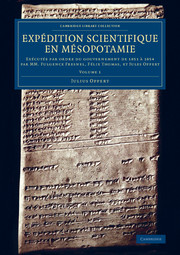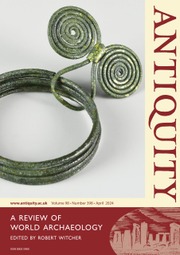Expédition scientifique en Mésopotamie
Born in Hamburg to Jewish parents, Julius Oppert (1825–1905) later moved to France, where he established a reputation as a remarkably gifted Assyriologist, making significant contributions to the decipherment of cuneiform Akkadian. Between 1851 and 1854, he accompanied the orientalist Fulgence Fresnel (1795–1855) on the French expedition to Mesopotamia. In recognition of his role, involving important excavations at the site of the ancient city of Babylon, Oppert was granted French citizenship. In May 1855, however, a great many of the discovered antiquities were lost when the raft transporting them sank in the Tigris under the weight of its priceless cargo. The present work appeared in two volumes between 1859 and 1863; the publication of the second volume preceded that of the first, as Oppert prioritised the analysis of the cuneiform inscriptions. Volume 2 (1859) is devoted to these inscriptions and the painstaking work of deciphering them.
Product details
November 2014Paperback
9781108078986
380 pages
297 × 210 × 20 mm
0.91kg
Available
Table of Contents
- Préface
- Introduction
- Part I. Des signes de l'écriture anarienne:
- 1. Bases du déchiffrement
- 2. Méthode de déchiffrement des signes étrangers aux noms propres
- 3. Caractère idéographique de l'écriture anarienne
- 4. De la polyphonie
- 5. Origine hiéroglyphique de l'écriture cunéiforme
- 6. Origine touranienne de l'écriture cunéiforme
- Part II. Interprétation des textes assyriens des rois achéménides:
- 1. Inscription de Xerxès à Van
- 2. Inscriptions de Persépolis
- 3. Grande inscription sépulcrale de Nakch-i-Roustam
- 4. Inscription de'Artaxerxès Mnémon à Suse
- 5. Inscription de Bisoutoun
- 6. Inscription des fenetres
- 7. Inscription assyrienne de Darius à Persépolis
- Part III. Déchiffrement des inscriptions unilingues de Babylone et de Ninive:
- 1. Inscription cursive de Nabuchodonosor, en six lignes
- 2. Inscription cursive de Nabuchodonosor, en huit lignes
- 3. Inscription du canal
- 4. Inscription du temple
- 5. Inscription de Londres
- 6. Inscriptions diverses des rois babyloniens
- 7. Inscriptions des briques de Ninive
- 8. Inscriptions du harem de Khorsabad
- 9. Tables votives de la fondation de Khorsabad
- 10. Noms des rois assyriens
- 11. Inscriptions de Sardanapale V.










